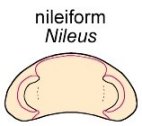
The facial sutures of Asaphiscus run from the anterior of the cephalon to the eye, then to the back of the cephalon.
They are lines on the cephalon along which the parts of the cephalon separate when the trilobite molts (sheds its exoskeleton -- see animation and discussion below). They typically run from somewhere along the anterior edge of the cephalon, toward and around the edge of the eye, and continue from there to end at either the side or rear of the cephalon. They are vital for proper molting and growth of trilobites, and they provide us with another character with which to help classify different trilobite groups.
There are three main categories of facial suture types (proparian, gonatoparian, and opisthoparian), described below. If you want more detailed definitions of the terms related to facial sutures, they can be found in the on-line glossary of trilobite terms.

The facial sutures determine the boundary between the central cranidium (glabella and fixed cheeks) and the librigenae (free cheeks). Trilobite specimens often lack librigenae. They are lost during molting, and also disarticulate easily following the death of the trilobite.

























